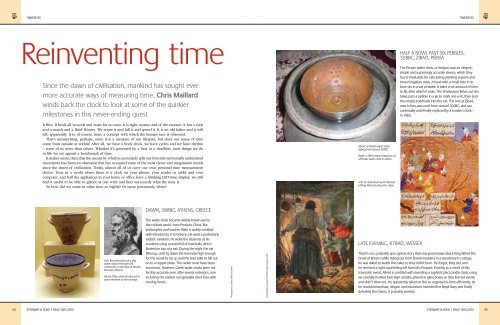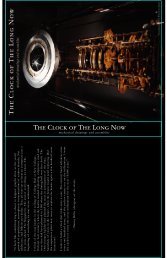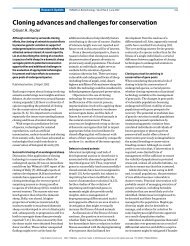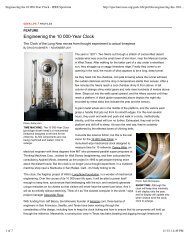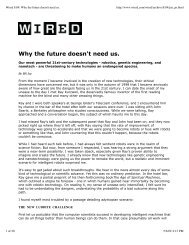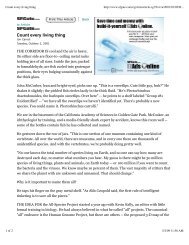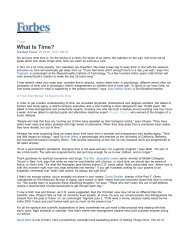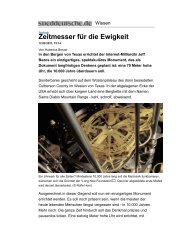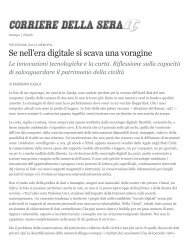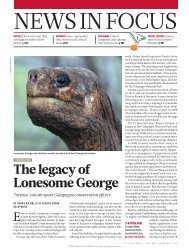PDF Download - The Long Now Foundation
PDF Download - The Long Now Foundation
PDF Download - The Long Now Foundation
You also want an ePaper? Increase the reach of your titles
YUMPU automatically turns print PDFs into web optimized ePapers that Google loves.
timepieces<br />
reinventing time<br />
since the dawn of civilisation, mankind has sought ever<br />
more accurate ways of measuring time. Chris Maillard<br />
winds back the clock to look at some of the quirkier<br />
milestones in this never-ending quest<br />
It flies. It heals all wounds and waits for no man. It is tight, money and of the essence. It has a nick<br />
and a march and a Brief History. We waste it and kill it and spend it. It is an old father and it will<br />
tell, apparently. It is, of course, time; a concept with which the human race is obsessed.<br />
That’s unsurprising, perhaps, since it is a measure of our lifespan, but does our sense of time<br />
come from outside or within? After all, we have a body clock, we have cycles and we have rhythm<br />
– some of us more than others. Whether it’s governed by a beat or a deadline, most things we do<br />
in life we set against a benchmark of time.<br />
It makes sense, then, that the means by which to accurately split our lives into universally understood<br />
increments has been an obsession that has occupied some of the most clever and imaginative minds<br />
since the dawn of civilisation. Today, almost all of us carry our own personal time measurement<br />
device. Even in a world where there is a clock on your phone, your reader or tablet and your<br />
computer, and half the appliances in your home or office have a blinking LED time display, we still<br />
find it useful to be able to glance at one wrist and find out exactly what the time is.<br />
So how did we come to value time so highly? Or more pertinently, when?<br />
94 steinway & sons | issUe two 2012<br />
Left: reconstruction of a clay<br />
water clock of the late 5th<br />
century Bc, in the stoà of attalus<br />
museum, athens.<br />
above: plato, who introduced an<br />
alarm element to the concept<br />
Dawn, 388Bc, athens, Greece<br />
the water clock became widely known across<br />
the civilised world, from persia to china. But<br />
philosopher and teacher plato is widely credited<br />
with introducing it to Greece. he used a particularly<br />
sadistic variation; he woke the students at his<br />
academy using a vessel full of lead balls, which<br />
floated on top of a vat. During the night the vat<br />
filled up, until by dawn the level was high enough<br />
for the vessel to tip up and the lead balls to fall out<br />
on to a copper plate. the racket must have been<br />
enormous. however, Greek water clocks were not<br />
terribly accurate even after several redesigns, one<br />
including the earliest recognisable clock face with<br />
moving hands.<br />
photography: Giovanni Dall’orto; alamy<br />
photography: creative commons; Getty images; corbis<br />
photography: creative commons; Getty images; corbis<br />
above: a persian water clock<br />
dating from around 500bc<br />
right: a 16th century depiction of<br />
a persian water clock in action<br />
left: an illustration by ac michael<br />
of King alfred burning the cakes<br />
late eveninG, 878ad, wessex<br />
Half a bowl past six pebbles,<br />
328bc, Zibad, persia<br />
timepieces<br />
the persian water clock, or fenjaan, was an elegant,<br />
simple and surprisingly accurate device, which they<br />
found invaluable for calculating planting seasons and<br />
timed irrigation rotas. a bowl with a small hole in its<br />
base sits in a vat of water. it takes a set amount of time<br />
to fill, after which it sinks. the timekeeper fishes out the<br />
bowl, puts a pebble in a jar to mark one unit, then puts<br />
the empty bowl back into the vat. the one at Zibad,<br />
now in iran, was used from around 300bc, and ran<br />
continually until finally replaced by a modern clock –<br />
in 1965.<br />
there’s one, probably apocryphal, story that everyone knows about King alfred the<br />
Great of britain: while hiding out from danish invaders in a woodsman’s cottage,<br />
he was asked to watch the cakes so they didn’t burn. He forgot, they did, and<br />
he received a right royal telling-off from mrs peasant. possibly as a result of this<br />
traumatic event, alfred is credited with inventing a sophisticated candle clock, using<br />
six carefully marked foot-high candles, placed in glass boxes so they burned evenly<br />
and didn’t blow out. He apparently relied on this to organise his time efficiently. as<br />
he revolutionised law, religion and education, invented the royal navy and finally<br />
defeated the danes, it probably worked.<br />
steinway & sons | issUe two 2012 95
Mozart set the standard in his field ...<br />
... It has been said we have as well.<br />
Phone: +1-973-993-1952 Fax: +1-973-538-5615 www.kscables.com<br />
photography: getty images; corbis; p Faligot<br />
photo credit:<br />
six beLLs o’ tHe First dog watcH,<br />
13 may, 1764, barbados<br />
at sea, accuracy is everything. John Harrison, a<br />
carpenter’s son and highly skilled clockmaker,<br />
solved the puzzle of building a timepiece that<br />
would withstand the humidity, damp and shocks<br />
of a long sea voyage and still stay accurate enough<br />
to calculate longitude to within yards. His second<br />
test voyage, to barbados, was final proof that his<br />
creation worked perfectly. as anyone who read the<br />
best-selling book on the subject, <strong>Long</strong>itude, will<br />
know, it took him far longer to solve the puzzle<br />
of getting britain’s establishment to pay him the<br />
promised prize money for his feat of horological<br />
engineering. meanwhile, seafarers, confusingly, were<br />
still telling time by splitting the 24 hour day into<br />
seven watches of eight half-hourly bells each...<br />
right: a rare example of a<br />
decimal timepiece made by<br />
18th century French watchmaker<br />
robert robin<br />
below: a scene from the French<br />
revolution by Jean-Victor schnetz<br />
Left: detail of an oil painting by<br />
thomas King of John Harrison<br />
right: an earlier experimental<br />
effort at keeping accurate time<br />
at sea, built by Harrison in 1735<br />
timepieces<br />
5:68:97, 5 october, 1793, paris<br />
the French revolution came with quite a few good<br />
ideas. However, one of its less successful brainwaves<br />
was the decimal clock. according to a 1793 decree,<br />
this divided the (previously) 24 hour day into 10<br />
hours, each one of 100 minutes, split into 100<br />
seconds. on the surface this was highly logical, but it<br />
quite simply failed to catch on – the population were<br />
just too used to the traditional system, and the cost<br />
of altering all existing clocks and watches, even then,<br />
was prohibitive. a brief attempt at re-starting the<br />
idea was made in 1897, but met the same problems.<br />
Logical? oui. popular? non.<br />
steinway & sons | issUe two 2012 97
timepieces<br />
above: the shepherd Gate<br />
clock, mounted outside<br />
the royal Greenwich<br />
observatory, showing<br />
Greenwich mean time<br />
98 steinway & sons | issUe two 2012<br />
2:37pm (London),<br />
2:37pm (BristoL),<br />
22 septemBer, 1847<br />
Until surprisingly recently, time was<br />
set by the sunrise. which was fine<br />
until the railways ushered in the era<br />
of high-speed cross-country travel.<br />
in Britain, for instance, if you got on<br />
a train in London, by the time you<br />
travelled west to Bristol your pocket<br />
watch would be 10 minutes fast.<br />
this caused havoc, so in 1840 the<br />
Great western railway introduced<br />
standardised London time across its<br />
network. this was met by some stiff<br />
opposition locally – some stations<br />
even added a second minute hand<br />
to their clocks to display both<br />
times. However, in 1847 the central<br />
railway clearing House decreed<br />
that Greenwich mean time should<br />
be used throughout the railway<br />
system. it still couldn’t make the<br />
trains run on time.<br />
11:00am eastern dayLiGHt time, 18 may, 2012<br />
above: a prototype of<br />
the 10,000 year clock,<br />
currently being assembled<br />
inside a mountain in texas<br />
crowdsourced fundraising website Kickstarter is a brilliantly simple idea. a would-be entrepreneur or<br />
artist puts a description of a project and the amount it needs on the site; anybody can take a look<br />
and decide whether to back it or not. the sums involved are usually small and if a project doesn’t<br />
meet its target, nobody has to pay. But one project, pebble, which officially finished its fundraising on<br />
18 may, has blown the model sky high. Looking for $100,000, it hit $1million in just 28 hours and had<br />
to pause its appeal with over $10million in the pot. what is this brand new genius idea? a watch. yes,<br />
it does some neat tricks with Bluetooth and apps, but mostly it’s a thing that sits on your wrist and<br />
tells you one vital, eternal fact: the time.<br />
0:00:00, 1 JanUary, 2000,<br />
san Francisco<br />
with a double bong, the first prototype of the<br />
10,000 year clock heralded the millennium.<br />
now ticking very slowly in London’s science<br />
museum, this was a trial run for an astonishing<br />
project: a clock, buried inside a remote texas<br />
mountain, built to run for 10,000 years. Funded<br />
by amazon billionaire Jeff Bezos and led by<br />
inventor and scientist danny Hillis, the team<br />
from san Francisco are excavating the site and<br />
building the huge mechanism, which will be<br />
powered by thermal energy and human visitors<br />
(if indeed there are any in 10,000 years time).<br />
made to self-adjust, never need lubrication, and<br />
resist corrosion for an almost unimaginably long<br />
time, this is futuristic in the most extreme sense<br />
of the word.<br />
above left: three models<br />
of the pebble watch, which<br />
raised $10m in investment<br />
capital via the internet<br />
photography: corbis; rolfe Horn courtesy of the <strong>Long</strong> now <strong>Foundation</strong><br />
one day Leads to another<br />
Light years ahead<br />
h moser & cie is a 200-year-old swiss watchmaking company that burst back onto<br />
the international scene in 2005 after a period of quiet. the watch that got the world<br />
talking was the moser perpetual 1, the first watch to display the date as a digit, without<br />
the need for manual adjustment. it took a particularly clever complication to manage<br />
the inconsistent lengths of the calendar months and display the change from, say,<br />
28 February to 1 march without having to spool through 29, 30 and 31. But moser<br />
mastered it. and yes, it took leap years into account too. Further innovations from<br />
moser include the perpetual moon, which features a display of the phases of the moon<br />
that deviates by no more than one day in 1,027 years!<br />
www.h-moser.com<br />
timepieces<br />
François-paul Journe is a watchmaker who is forever striving for new<br />
ways to measure time. in 2010 he won the Best technical innovation<br />
award at the champions of time event in china for his Vagabondage ii,<br />
a watch that used a mechanical movement to display the time digitally.<br />
clever stuff. that movement, as with all Fp Journe watches before it,<br />
was crafted from 18k rose gold, but a move into sports watches has<br />
prompted a shift away from his precious metal of choice and into hightech<br />
aluminium alloy – the kind used in aeronautics. it’s lighter, you see.<br />
Fp Journe’s “linesport” series offer the mechanical precision of<br />
haute horology in a body so light you barely notice you’re wearing it.<br />
the flagship model, centigraphe sport, weighs just 55g including the<br />
strap. it is all aluminium, specially formulated to be scratch resistant,<br />
anti-corrosive and anti-allergic. Little bits of rubber here and there act<br />
like car bumpers, protecting it from dents. the face is in dark grey with<br />
red numerals on the three chronograph dials, showing 1/100ths of a<br />
second, 20 second and 10 minute cycles. now the centigraphe sport<br />
has been joined by the 53g octa sport, a simpler design, which has<br />
a separate seconds dial, as well as date, power reserve and day/night<br />
displays, and a choice of rubber or aluminium straps.<br />
the first centigraphe sport was auctioned by christie’s in aid of<br />
survivors of the Japanese earthquake in 2011, and raised Us$465,170<br />
– about eight times its retail value. thirty per cent of the profit<br />
from every watch sold is donated to icm in paris, an institute for the<br />
treatment of brain and spinal cord ailments.<br />
www.fpjourne.com<br />
steinway & sons | issUe two 2012 99
AdvertoriAl FeAture<br />
Craftsmanship and performance<br />
in perfect harmony<br />
when lotus won the 1965 indianapolis 500, it was<br />
the first time a mid-engined car had triumphed at<br />
the legendary race. in watchmaking terms, the creation<br />
by F.P. Journe of the world’s first all-aluminium wristwatch,<br />
the Centigraphe Sport, was equally innovative.<br />
Given their respective penchants for innovation<br />
and joint passion for precision craftsmanship and<br />
performance, it is hardly surprising that F.P. Journe<br />
should have chosen to partner with lotus and Jean Alesi<br />
for his first indy 500 outing.<br />
the first step of a potentially fruitful partnership<br />
took place in May of this year in the legendary motor<br />
race when Jean Alesi took to the track wearing an F.P.<br />
Journe Centigraphe Sport watch, made entirely of hightechnology<br />
aluminium alloy.<br />
the journey from 18K rose gold, used by F.P. Journe<br />
in all its other movements, to aluminium has not been<br />
without difficulty and goes some way to explaining<br />
why the first Centigraphe Sport timepiece, numbered<br />
001, was auctioned by Christie’s in their Hong Kong<br />
sale of May 20, 2011, and achieved an amazing sale<br />
price of HK$3,620,000/uS$465,170 – close to 10<br />
times its original estimate. it is worthwhile noting that<br />
the entire amount was donated to the Franco-Japanese<br />
<strong>Foundation</strong>de Fère (http://fondationdefere.wordpress.<br />
com/) and to doctors of the world Japan (http://www.<br />
mdm.or.jp/) helping to finance the construction of a<br />
community centre in ishinomaki, near Sendai on the<br />
Japanese coast, to reunite family victims of the tsunami.<br />
100 SteinwAy & SonS | iSSue two 2012<br />
Above: the lotuS car in<br />
partnership with F.P. Journe.<br />
right: the F.P. Journe<br />
Centigraphe Sport watch worn<br />
by Jean Alesi on his first indy<br />
500 outing in May. Below:<br />
the first Centigraphe Sport<br />
watch (numbered 001) from<br />
F.P. Journe’s new “Sport line”<br />
collection was auctioned off in<br />
May in support of the victims<br />
of the Japan earthquake and<br />
tsunami. Bottom: Master<br />
watchmaker François-Paul Journe<br />
explaining a movement to his<br />
good friend Jean Alesi.<br />
the partnership will cement the history of two friends<br />
from the south of France who met through a love of<br />
beautiful technology: Formula 1 legend Jean Alesi and<br />
master watchmaker François-Paul Journe.<br />
Deep thinking<br />
all in one case<br />
in 1923, Rolex took the concept of time into a new dimension:<br />
underwater. the Rolex oyster was the world’s first waterproof wristwatch<br />
and paved the way for Rolex to become the diver’s watch. in 1960, a<br />
special one-off Rolex “Deepsea” was attached to oceanographer Jacques<br />
piccard’s submersible that went to the bottom of the marianas trench.<br />
piccard sent a telegram to Rolex, reading, “am happy to confirm that<br />
even at 11,000 metres your watch is as precise as on the surface.” today<br />
the Rolex Deepsea (pictured) maintains that standard of water resistance,<br />
together with that unmistakeable Rolex style.<br />
timepieces<br />
the oldest of the great swiss watchmakers, Vacheron constantin,<br />
proved its pedigree for innovation in the 1950s when it produced the<br />
world’s thinnest wristwatch, the patrimony, measuring just 5.25mm<br />
thick. to mark its 250th anniversary in 2005, it decided to really show<br />
off by putting sixteen complications into one watch: the limited edition<br />
tour de l’ile (pictured). a spellbinding combination of temporal and<br />
astronomical displays, requiring the use of two faces (front and back)<br />
and 834 individual parts, it was considerably thicker than the original<br />
patrimony, but with just seven made, it became an instant horological<br />
legend. if you can lay your hands on one today, expect to pay<br />
considerably more than the original $1.5m price tag.<br />
www.vacheron-constantin.com<br />
mateRial gain<br />
patek philippe is a company that’s not afraid to focus its innovative<br />
brains on the minutiae, and in 2005, in collaboration with centre<br />
suisse d’electronique et de microtechnique (csem), it developed a<br />
breakthrough component that sits virtually hidden deep inside the<br />
mechanism. it was an escape wheel, just like any other escape wheel,<br />
except it was made out of a silica compound they called silinvar. Unlike<br />
steel escape wheels, it required no lubrication and it could be made in<br />
a one-step process called Deep Reactive ion etching (DRie). in short,<br />
it was more precise. this technology has enabled patek philippe to<br />
develop further components that enhance the precision of its watches,<br />
such as the spiromax hairspring, which featured for the first time in the<br />
limited edition Ref. 5350 (pictured), launched in 2006.<br />
steinway & sons | issUe two 2012 101


